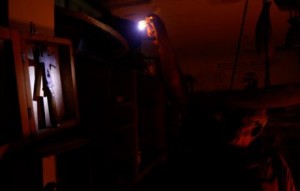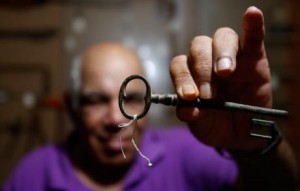The Memories Museum of Dr. Mohammed al-Khatib
By Yazan al-Saadi, Wednesday, August 7, 2013
In the midst of one of the many cramped and crowded alleyways of Beirut’s Shatila refugee camp, close to qa’at al-sha’ab, or the people’s hall, is a brown metal door leading to a ground-floor apartment. On the old door, written in white paint, is an Arabic poem:
Memories Museum,
For every object there is a story,
And from every corner choking agonyDoctor Mohammed al-Khatib
Welcome to the relatively unknown museum of 66-year-old Mohammed al-Khatib, a bulky man with bushy eyebrows and a charming personality.
Like memory manifested into physical form, walk into the museum and see hundreds of objects chaotically hanging from the ceiling, scattered on shelves, or strewn along the floor; a total of 1,000 objects amassed since the museum’s establishment back in 2004.
This assorted collection comes from Palestinians who carried a jumble of personal objects as they desperately fled the 1947-48 ethnic cleansing by Zionist forces.
There are farmer’s tools, utensils for eating and cooking, and traditional Palestinian clothing draped on a mannequin. There is a wooden replica of a ship at one corner, and beneath it a handcrafted replica of an old Palestinian home. On another shelf, small glass jars hold soil from four areas in occupied Palestine. Elsewhere, an old hunting rifle hangs in a dust-coated cabinet. On shelves there are old radios, Palestinian coins and paper currency, classic copper alarm clocks, brass coffee cups, and more objects than the eye can take in at first glance. A book shelf holds titles from an array of topics, medical to political, fiction and non-fiction. At the center of the main room stands a table with a chess board speckled by cigarette ash, the chess pieces dispersed as if from the aftermath of an antiquated battle.
The smell of dust and humidity hover heavily in the air intermixed with a mood of melancholy and hopeful defiance.
When there is electricity, harsh white fluorescent light brightens the unventilated rooms. When electricity is out, a common occurrence, soft candle light illuminates the objects, casting wild shadows across the stained cracked walls. Outside, the murmuring sounds of life’s bustle floats in.
By your side, Khatib casually guides you from object to object, each with a story that he remembers well and quickly shares in an energetic flurry that twirls history, personal tales of the objects’ previous owners, and punctuated by Khatib’s own memories of his past.
“I’ve done this to preserve the objects Palestinians brought with them from Palestine in 1947-1951. This is to protect our heritage,” he said. “I wanted to give the Palestinian children an opportunity to see and touch things rather than just reading about them.”
This type of work is urgently important for Khatib; it is a matter of preserving existence in the face of Israel’s attempt to rewrite Palestine and the Palestinians out of the pages of history.
“Israel stole the land and are trying to steal everything else,” he said. “They are trying to steal heritage and even the food. Here, at the museum, you are not only showing history, but also the modern face of the Palestinian people. We are not just poor refugees living in camps. No. We have culture and heritage. That is why it’s important to preserve it.”
He added, “If we do not encourage the mind for the next generation, then the fabricated history of the Israelis will become true.”
Shatila Memories
Khatib was born in a Palestinian village called al-Khalsa in 1947. He has two brothers and a sister. When he was only six-months-old, his family was forcibly expelled by Zionist forces. Eventually, they settled in the southern Lebanese village of Haboush.
It was in Haboush, Khatib remembers, where he first confronted the restless need to return to Palestine.
“I was playing with some Lebanese children when suddenly one of them said they were going to their farm and he left. One by one the other children said the same and started leaving. I started thinking how come all them had a farm and I didn’t, and I felt this deep sorrow,” he reminisced.
As he went home and shared his sorrow with his mother, she too felt saddened and began to tell him the story of Palestine and the people’s desire to return.
“That was how the idea was born and never left my mind: that I have to return to Palestine, I have to return to our home,” he said.
His family then moved again to Nabatieh, where he was educated in an UNRWA school and entered into medicine. Eventually, his studies took him to Spain for a spell and finally he returned to Lebanon to live and work in Akka Hospital near Shatila camp.
It was during that period of work that he survived the 1982 massacre, an event that vividly echoes in his mind. He lost many friends and colleagues during the massacre.
“I wrote about it in detail. When something is traumatic and affects your mind like this you have to write it down to remember. When someone brings it up, sometimes I just want to pull my hair out,” he said in a warm, humorous voice.
“I survived because of luck and quick decisions. Fight or flight. I was the one who ran. It was fast decisions and other people around me who made other decisions got killed,” he said, pausing to light a cigarette.
Khatib has one object from the massacre, a rusted tiny ax used by the perpetrators. The faded words ‘Sword Fish Brand’ and ‘Made in China’ are etched on the handle. The ax, one of five found discarded in the streets of the camp, was given to him by a young Palestinian man named Abu Hassan.
But the tragedies wouldn’t end for Khatib. Only a handful of years later, he would lose his only two children, a boy and a girl, during the sub-conflict known as the “War of the Camps.” The deaths resulted in a divorce with his wife at the time. Khatib did remarry, but age made it difficult to have children with his second wife.
“This is our story with life,” he said, lighting up another cigarette.
“Human beings should always write their memories down. If memory goes, you don’t exist. Everything disappears,” he mused as the smoke dissipated into the air.
Khatib continued to work as a doctor with hospitals and UNRWA until he decided to retire at the age of 60 in order to concentrate on maintaining the museum.
Stories Living in Objects
The ground-floor apartment that houses the museum was formerly a space for monthly discussions on a variety of topics by the Palestinian community in the camp. Khatib was an active participant in these discussions, which he thoroughly enjoyed. When the discussions petered out, he decided to start collecting objects from Palestine and quickly began to convert the space into a museum.
Since the museum’s establishment in 2004, Khatib claims that he has spent $43,000 from his own savings in order to collect objects from people, travel around Lebanon and Syria, and to fix up the museum.

Dr. Mohammed al-Khatib shines a light on a tiny axe that was used by the perpetrators of the Sabra and Shatila massacre. (Photo: Marwan Tahtah)
He receives no help from any political party or organization despite the fact that he has written letters to them about the project and its costs. There were no replies and no active initiatives to take children on museum visits. At one point, he was able to get some schools and centers to bring children on a weekly basis so they could see the objects and hear tales of the past.
“The children were so very inquisitive and curious about everything. They kept on asking questions about this and that,” he said with a laugh. However, that too ended over time.
The Memories Museum needs quite a few renovations. The back walls have been stained by water leakages from the rain, the objects need to be organized and archived digitally, shelves need to be fixed.
However, there is hope. An array of people from different backgrounds have banded together to raise funds and help revive the museum in the next couple of months.
One of those involved is Amany al-Sayyed, an English professor at the American University of Beirut, who hopes to record the stories of the previous owners and Khatib himself. Once collected, a website will be set up in order to represent the different language dialects. Her desire as well is to turn these tales into a children’s story book.
“For me, as a Palestinian coming from a writing background, I’m around stories. My father isn’t around anymore and I want my niece in America to hear and see these things,” she said during a brief telephone conversation. “This is about contributing for self-preservation. Without memory there is no self-preservation. This is the ideal place.”
“I don’t care if some of them are not historically accurate even. These are stories. If you want history, go to the history books. These stories reconnect people with their heritage, especially the Palestinian youth in the diaspora who do not have that access,” she added.
Sayyed also noted she was inspired and moved by Khatib’s honesty and dedication to this project.
“He’s a character that is doing what governments need to be doing. He is a storyteller and has an amazing archive of stories,” she said of Khatib.
Rosemary Sayigh, a British-born anthropologist and oral historian living in Beirut, has known Khatib for a while, conducting interviews with him on his experiences during the War of the Camps. She found out about the museum in March.
“As Dr. Mohammed says, Palestinian camps are represented as places of poverty and even crime. The museum is one move to show insiders and outsiders that camps contain people with a tradition of making and collecting beautiful objects,” she wrote in an email response to Al-Akhbar.
Sayigh also noted that the Memories Museum is not the only one of its kind in Lebanon. There is an old one in Ma’shouq near Sour that was created by a retired UNRWA head teacher, as well as a small collection of pre-1948 artifacts at the cultural center in Mar Elias.
Recently, Sayigh wrote about these types of museums in a fascinating article for Electronic Intifada examining the similarities and social subtexts driving the desires to set up these local museums.
In her conclusion, she noted: “It seems as if the fading away of the ‘generation of Palestine’ has inspired exiled Palestinians to grasp whatever is left of connection with the homeland … Local museums have a long tradition among Palestinians, going back to the collections of Jerusalem families and to folklorists. The need to preserve is a feeling expressed today by any Palestinian on the street, outside or inside the West Bank and Gaza.”
“This is not about making money,” Khatib said as the tour ended. “This is for my people and for my cause.”
http://english.al-akhbar.com/content/memories-museum-dr-mohammed-al-khatib or http://bit.ly/1cJMJC1




1 pings
[…] The dark double-quotes above the section are too garish. How can I specify the CSS in a child theme to either eliminate them, or replace them with light gray "classical" double-quotes? To see the current situation, go to https://levantium.com/2013/09/14/and-from-every-corner-choking-agony/ […]